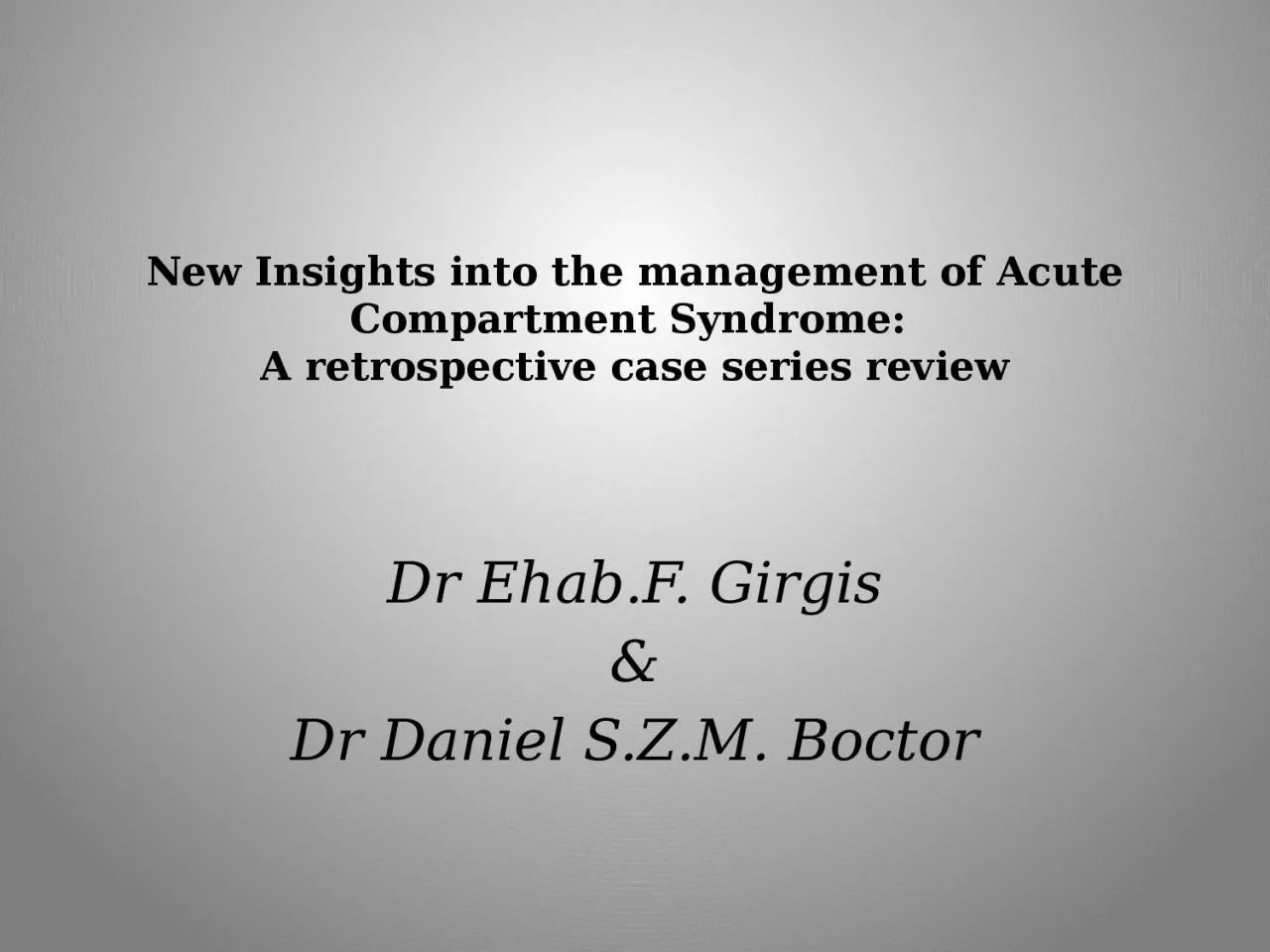

A retrospective case series review Dr EhabF Girgis amp Dr Daniel SZM Boctor TAKE HOME MESSAGES 1 THINK ABOUT SOFT TISSUE INJURY 2 COMPARTMENT SYNDROME CAN BE SPONTANEOUS 3 COMPARTMENT SYNDROME CAN BE SPONTANEOUS amp UPPER ARM ID: 919240
Download Presentation The PPT/PDF document "New Insights into the management of Acut..." is the property of its rightful owner. Permission is granted to download and print the materials on this web site for personal, non-commercial use only, and to display it on your personal computer provided you do not modify the materials and that you retain all copyright notices contained in the materials. By downloading content from our website, you accept the terms of this agreement.
Slide1
New Insights into the management of Acute Compartment Syndrome: A retrospective case series review
Dr
Ehab.F
.
Girgis
&
Dr
Daniel S.Z.M. Boctor
Slide2TAKE HOME MESSAGES1. THINK ABOUT SOFT TISSUE INJURY
2. COMPARTMENT SYNDROME CAN BE
SPONTANEOUS
3. COMPARTMENT SYNDROME CAN BE SPONTANEOUS & UPPER ARM
4. COMPARTMENT SYNDROME AND OPERATIVE POSITIONING!!!
5. ANALGESIA AND COMPARTMENT SYNDROME!!
Slide3SO DON’T MISS THE DIAGNOSIS!!
Slide4INCLUSION CRITERIARetrospective review of clinical and radiological records of 41 patients diagnosed with ACS
.
1999
to 2013 done under the care of orthopaedic
team
EXCLUSION CRITERIA:
1
- Patients diagnosed with chronic compartment syndrome.
2- Patients with post-ischaemic acute compartment
syndrome
(ACS) done by the vascular surgeons.
3- Patients with ACS who had
fasciotomy
carried out by the plastics team
.
Slide5CAUSES OF ACUTE COMPARTMENT SYNDROME:1- Fractures (25 patients
)
2
- Soft tissue injury: (14 patients)
A)
Crush Injury ( 10
patients).
B)
Crush Syndrome (6 limbs in 4 patients
)
3
- Spontaneous (2 patients
)
Slide6CRUSH INJURIES"Acute compartment syndrome in the absence of fracture " Hope M.J . and M.M. Journal of Orthopaedic Trauma, 2004.
Patients with ACS in the absence of fracture were:
Older
M
ore co-morbidities
Significantly greater mean delay to
fasciotomy
of 12.4 hours compared with those with fractures.
At
fasciotomy
, they had 20% muscle necrosis
compared with 8%.
Slide7TAKE HOME MESSAGE 1: THINK ABOUT SOFT TISSUE INJURY
Slide820 year old female with IDDMSudden pain in the calf whilst
walking
Attended ED and given analgesia for muscular pain
4 days later: Pain severe, throbbing, intermittent
below the knee and became throbbing
Area
of redness plus tenderness over the lateral aspect of the lower
leg: ?cellulitis
or DVT
CASE PRESENTATION NUMBER 1
Slide9Next morning numbness in the foot: Fasciotomy
Findings: dead muscle throughout the lateral compartment - Debrided
Loss of eversion (
peroneal
muscles)
Slide10TAKE HOME MESSAGE 2:
COMPARTMENT SYNDROME CAN BE
SPONTANEOUS
Always
consider spontaneous ACS in your differential diagnosis of rapid onset
of
painful swollen limb without history of injury. Doctors usually think about infection or DVT.
Slide11CASE PRESENTATION NUMBER 270 year old female
In-patient under the medical team for
COPD
On
Clopidogrel
and prophylactic low dose of anti-
coagulant
Developed swelling over the
antero
-medial aspect of
upper arm
Medical doctor on-call at night suspected axillary
DVT:
Prescribed
therapuetic
dose of anti-coagulant
Slide12Increased size and pain with numbness in the left handO/E:
Tender swollen biceps
Radial pulse is palpable
Median nerve symptoms
CT scan: haematoma left biceps and distal part of deltoid.
Urgent decompression:
On release of biceps muscle sheath 700ml of blood
Slide13Picture in OR.jp
Slide14Body part affectedLower leg 24
Forearm
13
Thigh 3 (one plus gluteal)
Foot
2
Upper
arm
1
Slide15TAKE HOME MESSAGE 3: COMPARTMENT SYNDROME CAN BE SPONTANEOUS &
UPPER ARM
Slide16O
nly the second reported case of spontaneous upper arm compartment syndrome
The first reported case in a patient who was
not
on warfarin.
Spontaneous Compartment Syndrome of the Upper Arm in a Patient Receiving Anticoagulation Therapy
”
David C. Zimmerman,
Tushar
Kapoor
, Mikhail
Elfond
, Paul Scott
(JOURNAL OF EMERGENCY MEDICINE 2013)
Slide17CASE PRESENTATION 342
year old
male, Overweight
113Kg
Elective
operation for anterior resection of Cancer
rectum
Legs were elevated in Lloyd-Davis leg holders.
Prolonged
operation for 6 hours as tumour was adherent
Post
-operative epidural analgesia infusion (
Bupivicaine
0.1% + 2mg/ml Fentanyl)
Slide18Thirty six hours later:- Patient developed severe pain with tense swollen lower legs- Pain on dorsiflexion of the ankle
- Decreased sensation in all the nerves distribution except the saphenous nerve.
Bilateral
fasciotomy
4 hours later
FINDINGS: All 4 compartments bilaterally were tense with muscle escape but healthy muscles.
Slide19TAKE HOME MESSAGE 4:
COMPARTMENT SYNDROME AND OPERATIVE POSITIONING!!!
Courtesy of
normadnd.com
Slide20CASE PRESENTATION 419yo male motorbike RTA: Femoral fracture
Difficult IM nail – long operation
Patient on traction table
Post-op: Vague and fluctuating Symptoms:
Numbness
i
n leg, lower leg & foot
Increasing pain (no longer controlled by analgesia) (7 doses x 20mg
Oramorph
)
“All pain killers not working, doctor called”
Slide21Later lower leg tense – taken for fasciotomy
Surgery:
1
st
Look: Some debridement anterior compartment
2
nd
look: Most of anterior compartment dead
Foot drop Required tendon transfer
NCS:
Peronal
nerve – ischaemic
axonopathy
Follow up at 1 year: Same numbness present
Slide22TAKE HOME MESSAGE 4:COMPARTMENT SYNDROME AND OPERATIVE POSITIONING!!!
ACS can develop in a compartment distal to the compartments with the fractured bone
Slide23TAKE HOME MESSAGE 5: ANALGESIA AND COMPARTMENT SYNDROME!!
Slide24OUR STUDY1 patient: Diagnosis or masking of the pain
1 patient had post-operative epidural analgesia infusion which did not mask his ACS symptoms.
LITERATURE
Postal survey to anaesthetists: They had seen cases of ACS being masked by regional anaesthesia.
"The use of regional anaesthesia in patients at risk of acute compartment syndrome" Davis et al. Injury. 2006
Vs
Systematic review of 32 patients, symptoms and signs of ACS were present in the presence of epidural analgesia.
Mar G.J. et al. British Journal of Anaesthesia. 2009
Slide25TAKE HOME MESSAGES1. THINK ABOUT SOFT TISSUE INJURY
2. COMPARTMENT SYNDROME CAN BE
SPONTANEOUS
3. COMPARTMENT SYNDROME CAN BE SPONTANEOUS & UPPER ARM
4. COMPARTMENT SYNDROME AND OPERATIVE POSITIONING!!!
5. ANALGESIA AND COMPARTMENT SYNDROME!!
Slide26SO DON’T MISS THE DIAGNOSIS!!